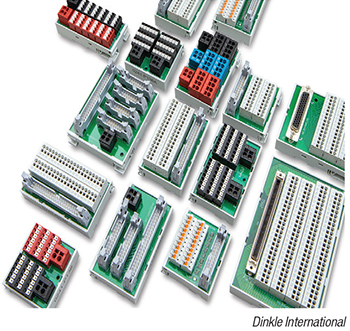 This line of interface modules (photo) are used to simplify and improve reliability of automation connections and signal conversions. When creating automation systems using major PLC brands, designers are challenged to connect an ever-increasing number of equipment signals to the I/O modules. These signals may be discrete (on/off at anywhere from 5 V d.c. up to 120 V a.c.), analog (usually 4–20 mA or 0–10 V d.c.), or other specialized signaling levels. Even standardized equipment designs may need to be automated using a variety of controller and I/O models to comply with end user requirements. Instead of being constrained to standard factory wiring arms and bulkier terminal blocks, users can gain flexibility selecting from a range of universal interface modules and associated cables, which are available with popular industry-standard connectors. A single wiring harness routes from the I/O module to the interface module. Some of these interface modules are available with traditional screw-cage terminal blocks, but most versions use newer push-in design (PID) terminations. — Dinkle International, Missouri City, Tex.
This line of interface modules (photo) are used to simplify and improve reliability of automation connections and signal conversions. When creating automation systems using major PLC brands, designers are challenged to connect an ever-increasing number of equipment signals to the I/O modules. These signals may be discrete (on/off at anywhere from 5 V d.c. up to 120 V a.c.), analog (usually 4–20 mA or 0–10 V d.c.), or other specialized signaling levels. Even standardized equipment designs may need to be automated using a variety of controller and I/O models to comply with end user requirements. Instead of being constrained to standard factory wiring arms and bulkier terminal blocks, users can gain flexibility selecting from a range of universal interface modules and associated cables, which are available with popular industry-standard connectors. A single wiring harness routes from the I/O module to the interface module. Some of these interface modules are available with traditional screw-cage terminal blocks, but most versions use newer push-in design (PID) terminations. — Dinkle International, Missouri City, Tex.